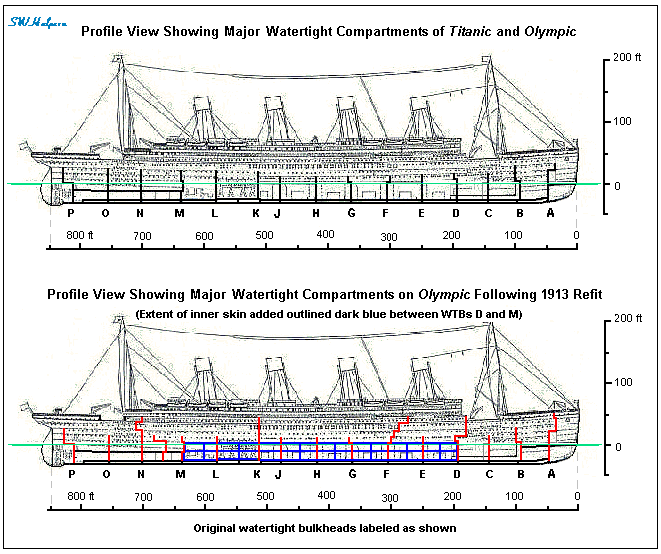| MODIFICATIONS TO OLYMPIC FOLLOWING THE TITANIC DISASTER |
| After the Titanic disaster, the Olympic underwent a major fit to increase her watertight integrity by increasing the number of major watertight compartments from 16 to 17, increasing the height and stiffening of 5 transverse watertight bulkheads (WTBs), and adding an inner skin to the hull in way of the machinery spaces. The intent was to be able to say that she would float with any group of six of the original major compartments flooded. To do that, a WTB was also added abaft the engine room, between two pairs of electric dynamo engines, and bulkheads A, D, F, K, and N were carried as high as Bridge deck B. In addition, the orlop deck in Hold No. 1 was made watertight, and an inner skin fitted from bulkhead D back to bulkhead M giving added protection to all six boiler rooms and the reciprocating and turbine engine rooms. |
| Besides the bulkhead modifications and the addition of an inner skin, changes were also made to the pumping arrangement on board with the addition of an extra line of piping. (For more details, please refer to fine books by Mark Chirnside, The 'Olympic' Class Ships: Olympic, Titanic & Britannic, and RMS Olympic: Titanic's Sister.) These modifications, really a knee-jerk reaction to the Titanic disaster, came at a cost; not only in monitary terms but also in passenger comfort by interfering with some of their movements. It made for some difficulties in passengers getting about. Below is a diagram that shows the original watertight bulkhead arrangement of Olympic and Titanic as completed, and the arrangement for Olympic following her refit in early 1913, including the extent of the added inner skin including its watertight subdivisions (all outlined in dark blue) and the her watertight bulkheads (shown in red). A picture of Olympic's profile with these changes can also be seen in Tom McCluskie's book, Anatomy of the Titanic, on pages 38-39. (Unfortunately, it was mislabeled as an internal profile of Titanic, which it is not.) |
| This inner skin, of about 1/2 inch steel plate, was carried from the tank top to the bottom of Middle deck F, and was spaced 36 inches from the outer hull plating between deck F and Lower deck G, and 30 inches from the outer hull plating below deck G, the depth of the original web frames. It then widened out to 4 feet at the tank top. The space between the inner and outer skins was also divided by watertight subdivisions, both horizontally and vertically, between the major watertight bulkheads therby dividing the space into a series of watertight compartments. Because of the added inner skin, the central boiler in boiler room No. 5 had to be replaced with one of slightly smaller diameter (going from 15' 9'' to 13' 6''). At the right is a partial cross-sectional diagram showing the added inner skin. The arrangement and height of the major watertight bulkheads was such that there were five groups of 6 ajoining major compartments that could be flooded without danger of the ship sinking. This did not make the ship into a 6 compartment vessel, as some people have been led to believe, because it was not any group of six that could be flooded, just 5 particular groups of six. In addition to some bulkheads being raised, three others were reduced in height because they no longer needed to go as high as they did before. These were bulkheads L, M, and O which originally were carried watertight to D deck, now they were carried watertight only to E deck as was the new bulkhead added between original bulkheads M and N that separated the electric dynamos into two compartments of 2 engines each. |
| Special thanks to Mark Chirnside and Bruce Beveridge for providing me with some detailed technical information on Olympic's refit. Other information came from the deposition of Edward Wilding from the Limitation of Liability Hearings in NY in May, 1915. |

